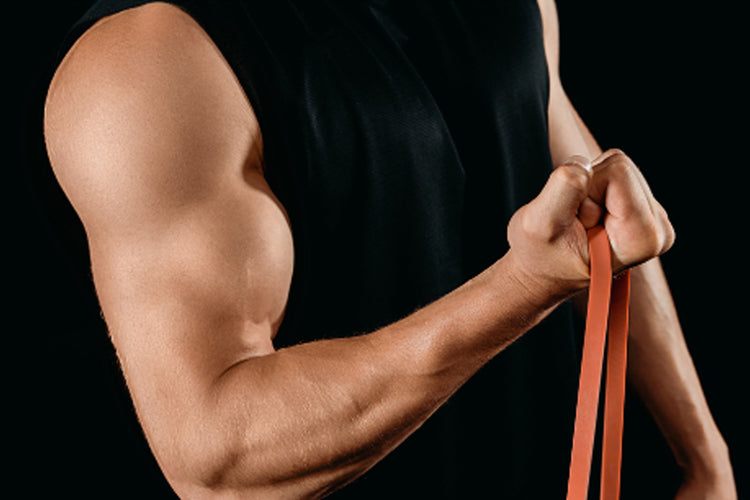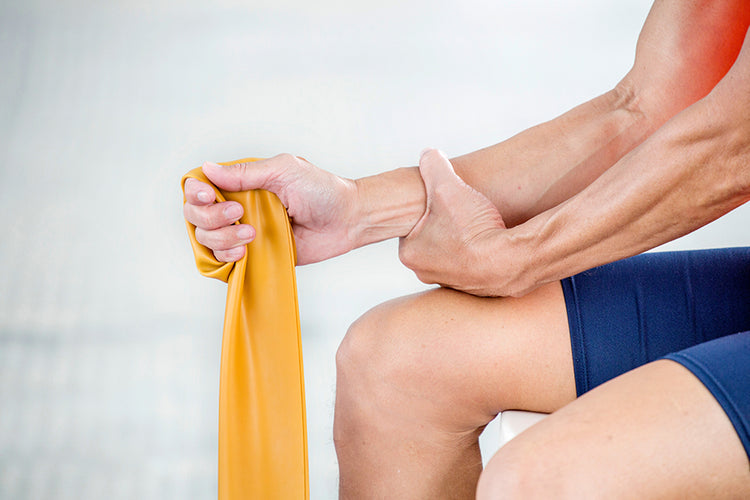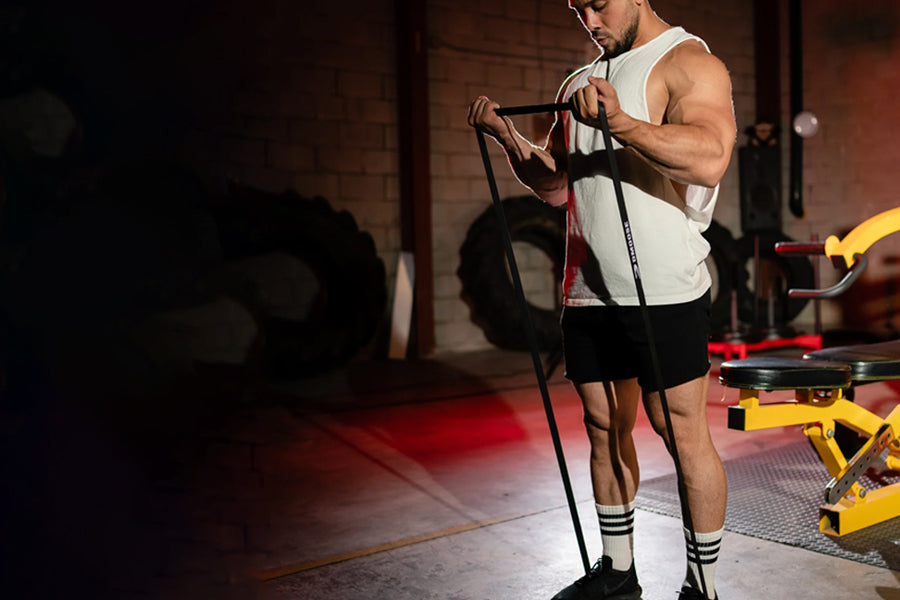Building strong, defined forearms is aesthetically appealing and crucial for enhancing grip strength and overall arm functionality. While traditional forearm exercises like wrist and forearm curls can be effective, incorporating resistance bands into your forearm workouts can take your training to the next level.
Forearm exercises with bands provide targeted resistance that engages the muscles in your forearms, helping you develop greater strength, endurance, and size. This comprehensive guide will explore the six best forearm exercises and workouts using bands.
Whether you're a beginner or an experienced fitness enthusiast, there's something here for everyone. So, grab your bands, get ready to work those forearms, and unlock your full potential!
Related Article: How Resistance Bands Improve Your Fitness Routine?
Understanding the Anatomy of Forearm Muscles
The forearm muscles, or the antebrachial muscles, are complex muscles between the elbow and wrist. Understanding their anatomy is crucial for anyone seeking to develop forearm strength, improve grip, or enhance upper body functionality.
The forearm comprises two main muscle groups: the flexors and the extensors. The flexor muscles are situated on the anterior (front) side of the forearm and are responsible for the flexion of the wrist and fingers. These muscles include the flexor carpi ulnaris, flexor carpi radialis, palmaris longus, and flexor digitorum superficialis. They are vital in gripping objects, grasping, and pulling movements.
We find the extensor muscles on the forearm's posterior (back) side. These muscles are responsible for extending the wrist and fingers and are crucial for movements such as releasing, pushing, and straightening the hand.
The extensor carpi ulnaris, extensor carpi radialis longus, extensor carpi radialis brevis, and extensor digitorum are key muscles in this group. In addition to the flexors and extensors, smaller, intrinsic muscles are located within the hand and forearm. These muscles, including the interossei and lumbricals, are responsible for intricate finger movements, such as spreading the fingers or performing fine motor tasks.
Targeting flexor and extensor muscles is important to develop well-rounded forearm strength. Neglecting one group can lead to imbalances, which may result in decreased performance and increased risk of injury.
Incorporating exercises such as wrist curls, reverse curls, pronation and supination, and finger extensions can effectively target these muscles and promote balanced forearm development. Understanding the anatomy of forearm muscles allows us to appreciate the complexity of these muscles and their role in various everyday and athletic activities.
Targeted exercises and training protocols can optimize our forearm strength, improve grip stability, and enhance our upper-body functionality.
Benefits of Training Your Forearms Using Bands

Training your forearms with bands offers many benefits that can significantly enhance your fitness and performance. By incorporating resistance bands into your forearm workouts, you can target specific muscles, improve grip strength, increase wrist stability, and develop overall forearm functionality.
Whether you're an athlete looking to enhance your performance in sports requiring strong grip and forearm strength or seeking to improve everyday tasks involving gripping and lifting, training your forearms with bands can be a game-changer.
Let's explore the various benefits of this training method.
Targeted Muscle Engagement
Resistance bands provide focused resistance that targets the muscles in your forearms, including the flexors and extensors. You can effectively isolate and engage these muscles by training with bands, promoting balanced forearm development.
Improved Grip Strength
Forearm band exercises require you to grip and maintain tension on the bands, strengthening your grip. Enhanced grip strength translates to improved performance in activities like weightlifting, rock climbing, and sports that involve holding objects or equipment.
Increased Wrist Stability
Band exercises challenge your wrist stability by creating resistance in various planes of motion. Training with bands helps stabilize and strengthen the muscles and ligaments surrounding the wrist joint, reducing the risk of injuries and improving overall wrist stability.
Functional Forearm Strength
Band training mimics real-life movements and everyday tasks involving gripping, lifting, and manipulating objects. By developing functional forearm strength, you can perform tasks more efficiently and with reduced fatigue.
Versatility and Convenience
Resistance bands are portable and can be easily carried and used anywhere, making forearm training accessible and convenient. Bands come in different resistance levels, allowing you to progressively increase the intensity of your workouts as your forearm strength improves.
Injury Prevention
Strong forearms and grip strength contribute to injury prevention by providing stability and control during physical activities. Well-developed forearm muscles can alleviate stress on the wrists and elbows, reducing the risk of overuse injuries.
As quoted by famous tennis player Serene Williams:
"Resistance bands have been a game-changer in my training. They provide a unique and versatile form of resistance that allows me to target specific muscle groups and improve my strength and power. Whether on the court, in the gym, or on the road, resistance bands are a portable and convenient tool that helps me maintain and enhance my athletic performance. They have become essential to my training routine, helping me push my limits and achieve new heights in my sport. If you're serious about taking your fitness to the next level, I highly recommend incorporating resistance bands into your workouts."
Incorporating forearm training with bands into your fitness routine can significantly impact your overall strength, performance, and injury prevention. By targeting specific muscles, improving grip strength and wrist stability, and developing functional forearm strength, you can enhance your athletic abilities, excel in sports, and improve your everyday activities that involve gripping and lifting.
6 Best Forearm Exercises & Workouts With Bands
Why choose bands for forearm exercises? DMoose Resistance bands offer a host of benefits. First and foremost, they provide constant tension throughout the entire range of motion, ensuring that your muscles are engaged and challenged throughout the exercise.
These bands are versatile and portable, making them an excellent option for home workouts, travel, or when you don't have access to a fully equipped gym. They can be easily adjusted to accommodate different fitness levels, allowing beginners and advanced individuals to reap the benefits of resistance training.
Now, let's dive into the six best forearm exercises and workouts with bands to help you build impressive forearm strength, improve grip, and enhance overall arm aesthetics.
1. Reverse Grip Wrist Curl
The reverse grip wrist curl is a powerful forearm exercise that targets the muscles on the backside of your forearms, known as the extensor muscles. You engage these muscles uniquely and effectively using a reverse grip, where your palms face downward instead of upward.
This wrist curls resistance band exercise primarily focuses on strengthening your wrist extensors, improving grip strength, and enhancing overall forearm development. Performing reverse grip wrist curls regularly can be particularly beneficial for athletes involved in activities that require strong wrist stability and control, such as tennis, golf, rock climbing, or weightlifting.
How to Do It:
- Attach a resistance band to a stable anchor point and hold the other end with an underhand grip.
- Sit on a bench or stand with your forearms resting on your thighs, palms facing upward.
- Slowly curl your wrists upward against the band's resistance, then return to the starting position.
- Perform three sets of 12-15 repetitions.
2. Finger Extensions
Finger extensions are a fundamental exercise that targets the muscles responsible for extending and straightening your fingers. This exercise is simple yet highly effective in building strength and flexibility in your hands and fingers.
Using a resistance band or other suitable equipment, you can provide controlled resistance against the finger flexor muscles, which are often overused in everyday activities. Finger extensions help balance the strength between the flexor and extensor muscles, promoting better hand function and reducing the risk of imbalances and injuries.
How to Do It:
- Place a resistance band around your fingers and rest your forearm on a flat surface.
- Start flexing your hand, then extend your fingers against the band's resistance.
- Hold the position for a few seconds before releasing.
- Aim for three sets of 10-12 repetitions.
3. Pronation/Supination
Pronation and supination are basic movements of the forearm that play a crucial role in various activities such as sports, weightlifting, and everyday tasks.
Pronation refers to the rotation of the forearm and hand inward, causing the palm to face downward, while supination involves the rotation outward, with the palm facing upward. Using resistance bands to target these movements can help strengthen the muscles responsible for pronation and supination, namely the pronator teres and supinator muscles.
How to Do It:
- Hold a resistance band with both hands in front of you, palms facing downward.
- Keep your elbows close to your sides and your forearms parallel to the ground.
- Rotate your forearms outward (supination) against the band's resistance, then rotate them inward (pronation).
- Perform three sets of 15-20 repetitions.
4. Single-Arm Forearm Curl
The single-arm forearm curl is a focused exercise that targets the muscles in your forearms, specifically the flexor muscles responsible for wrist and finger flexion.
By performing this exercise with one arm at a time, you can isolate and engage the muscles more effectively, enhancing strength and muscular development.
Single-arm forearm curls are an excellent choice for individuals looking to improve their grip strength, forearm stability, and overall upper body strength. You can also perform this forearm workout with dumbbells.
How to Do It:
- Step on the middle of a resistance band with one foot and hold the other end with an underhand grip.
- Keep your arm extended before you, then curl your wrist upward against the band's resistance.
- Slowly lower your hand back to the starting position.
- Aim for three sets of 12-15 repetitions on each arm.
5. Double-Arm Forearm Curl

The double-arm forearm curl resistance band is a versatile exercise that effectively targets and strengthens the muscles in both forearms simultaneously.
Simultaneously performing this exercise with both arms can promote symmetrical development and balanced forearm strength.
This exercise can be done using different equipment, such as DMoose adjustable dumbbells, barbells, or resistance bands, allowing you to customize the intensity and resistance to suit your fitness level.
The adjustable dumbbells by DMoose are multifunctional, offering incredible versatility, and are designed to maximize your fitness potential while saving valuable space.
With their adjustable nature, these dumbbells provide the ultimate convenience and portability, allowing you to carry them wherever you go for uninterrupted workouts.
Experience a full-body transformation as you target multiple muscle groups and unleash your full potential.
How to Do It:
- Stand in the middle of a resistance band with both feet, holding the ends of the band with an underhand grip.
- Keep your arms extended in front of you and curl both wrists simultaneously against the band's resistance.
- Lower your hands back to the starting position in a controlled manner.
- Perform three sets of 12-15 repetitions.
6. Forearm Band Extension

Forearm band extensions build forearm strength and improve wrist stability and flexibility, enhancing overall upper-body functionality. This exercise is precious for tennis, basketball, or rock climbing athletes, where strong wrist extension is essential for optimal performance.
By incorporating forearm bands into your workout routine, you can develop robust and resilient forearms, improve grip strength, and reduce the risk of imbalances or injuries in the forearm muscles.
How to Do It:
- Attach a forearm band to a stable anchor point and hold the other end with your hand, palm facing downward.
- Extend your wrist against the band's resistance, then return to the starting position.
- Perform three sets of 12-15 repetitions on each arm.
Incorporating these six best forearm exercises and workouts with bands into your training routine will help you develop stronger and more defined forearms. Remember to choose resistance bands with appropriate tension levels to suit your current strength and gradually increase the resistance as you progress.
Consistency, proper form, and gradual progression are crucial to achieving the best results in your forearm training journey.
Related Article: Build Muscles the Easy Way With Resistance Bands
FAQs
1. Are resistance bands influential as forearm workout tools?
Absolutely! Resistance bands are highly effective for forearm workouts. They provide constant tension throughout the entire range of motion, targeting the muscles in your forearms and promoting muscle growth and strength. The adjustable resistance levels offered by bands allow you to increase the challenge as you progress in your training gradually.
2. Can forearm exercises with bands help improve grip strength?
Yes, forearm exercises with bands are excellent for improving grip strength. Grip strength is crucial not only for lifting heavy weights but also for various daily activities and sports.
Resistance bands provide resistance in multiple directions, activating the muscles responsible for grip, such as the flexors and extensors in the forearms. Consistent training with bands can lead to significant improvements in grip strength.
3. Can I combine dumbbells and resistance bands for forearm workouts?
Absolutely! Combining dumbbells and resistance bands can provide an effective and varied forearm workout. Dumbbells offer a stable resistance, while bands provide accommodating resistance throughout the entire range of motion.
This combination allows you to target different muscle fibers and challenge your forearms from various angles, leading to comprehensive development.
4. How often should I perform forearm exercises with bands?
The frequency of your forearm workouts depends on your training goals and overall program. Generally, it is recommended to perform forearm exercises with bands 2-3 times per week, allowing for adequate rest and recovery between sessions.
Consistency is key, so choose a schedule that suits your lifestyle and commit to regular training. Gradually increase the intensity and resistance to continue challenging your forearms and promoting growth.
Takeaway
Incorporating forearm exercises and workouts with bands into your fitness routine can significantly impact your forearm strength, grip, and overall arm aesthetics. The targeted resistance bands allow you to effectively engage the muscles in your forearms, leading to increased muscle activation and growth.
Whether you perform the forearm resistance bands workout, forearm curl exercises, or utilize dumbbells in your routine, the key is consistency and progressive overload. Gradually increase the resistance and challenge your forearms to adapt and become stronger.
Strong forearms are visually appealing and vital to everyday activities and sports. Improved grip strength can enhance your performance in weightlifting, rock climbing, golf, and various other activities that require a strong grip.
So, grab your resistance bands and incorporate these practical forearm exercises into your training regimen. Be patient, stay consistent, and watch your forearms transform over time.














